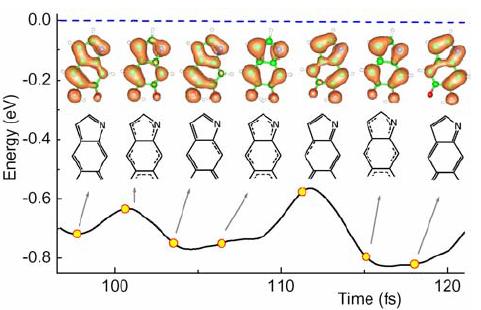电子激发态动力学 Excited state dynamics

Excited states exist readily in nature and even prevail over ground states, as we see in ignition, breath, vibration, and fluorescence. In fact all experimental probes activate the system to excited states for detection. However, a full description of excited states, at the atomic [molecular vibrations] and electronic [absorption and emission] level, especially the coupled ion-electron motions under strong field [quantum control], was never achieved.
We are in the progress of developing Time Dependent Density Functional Theory (TDDFT), which will enable us to monitor the evolution of electron wavefunctions around static nuclei or coupled with ionic movement under electronic excitations.
Within TDDFT, a number of new and accurate applications can be realized, such as optical responses to an electric field producing accurate absorption spectra and band-gaps, dynamics of excited electrons and chemical reaction pathways under a strong laser pulse, nonadiabatic scattering, and electron transport.

A prototype system for study would be photosynthesis: the chlorophyll molecules in the photosystem II adsorb sunlight and get excited, then the excited electrons are subsequently transferred through the peptides chain to split a water molecule. We would utilize real time and local basis sets for practical implementation, which have advantages of fast computation, high accuracy, and dealing with large biomolecules. This will also lead to spectroscopic applications, which allow direct comparisons with experiment. Currently we are applying this method to the study of nonradiative relaxtion mechanisms of melanin , the function for its photoprotection role, and the study of electron injection from dye molecules to semiconductors in solar cells. We also intend to develop new exchange-correlation functionals, new methods for extended systems, and new techniques for charge transfer, to complement the current theory.
